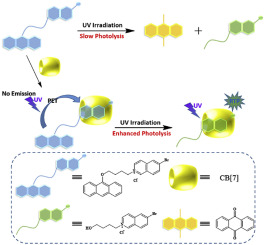Dyes and Pigments ( IF 4.1 ) Pub Date : 2017-09-18 , DOI: 10.1016/j.dyepig.2017.09.036 Teng Li , Xiang Ma

|
Photolyzable matric belongs to photo-responsive system that experiences irreversible decomposition after irradiation. While the self-aggregation of photosensitizers in aqueous media often results in lower photosensitizing ability. In this work, an enhanced photolyzable system is constructed through host-guest recognition between amphiphilic 6-bromoisoquinoline functionalized alkoxyanthracene (AnBq) and cucurbit[7]uril (CB[7]). In addition, a visible room-temperature phosphorescence (RTP) signal occurs along with the photolysis reaction as the suppression of intramolecular photoinduced electron transfer (PET) process from the anthracene moiety to phosphorous 6-bromoisoquinoline moiety. The formation of the host-guest assembly and the photolysis of AnBq are clearly corroborated through UV–Vis, NMR and MS spectroscopy. This photo-responsive host-guest assembly provides some hints for the design of photodegradable materials.
中文翻译:

客体超分子两亲物增强的光分解与响应的室温磷光信号
可光分解基质属于光响应系统,该系统在辐照后会发生不可逆的分解。尽管光敏剂在水性介质中的自聚集通常导致较低的光敏能力。在这项工作中,通过两亲6-溴异喹啉官能化的烷氧基蒽(AnBq)和葫芦[7] uril(CB [7])之间的客体识别,构建了增强的光解体系。另外,可见的室温磷光(RTP)信号与光解反应一起发生,因为抑制了分子内光致电子转移(PET)过程从蒽部分到磷6-溴异喹啉部分。客座组装体的形成和AnBq的光解通过UV-Vis,NMR和MS光谱明显证实了这一点。这种对光敏感的主宾系统可以为可光降解材料的设计提供一些提示。









































 京公网安备 11010802027423号
京公网安备 11010802027423号